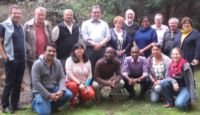The initial ecclesiological insights of catholic action
In 1916, Pope Pius XI created Catholic Action (CA) based on various, especially Italian apostolic realities of laypersons (the 1874 “Opera dei Congressi Cattolici”, the 1895 FUCI, the 1908 “Unione Donne”, etc.). The first statute defined C.A. as “the participation of the laity in the hierarchical apostolate”. The JOCI, as a specialized experience of C.A., begun by J. Cardijn in Brussels, was officially recognized in 1925. Subsequently, other specialized youth movements appeared such as MIJARC, JICI, MIDADE, JECI (inspired by the 1921 MIEC Pax Romana), as well as the corresponding movements for adults (MMTC, MIAMSI, FIMARC, MIIC).
What were the initial ecclesiological insights of MIIC ?
The urgent need for a meaningful Christian/Catholic presence, that is, an “apostolic” presence in the classical sense, in the labor, rural and agricultural, student and university, intellectual and cultural, independent and professional spheres.
– The central role of the laity. This was in harmony with the goal of the growing associations of the laity that considered the apostolic movements of and for laypersons as new subjects of the Church. This is why the management and the presidency of these movements went to the laypersons themselves.
– A special relation with the hierarchy : Pius XI spoke about “participation in the hierarchical apostolate”; Pius XII gave this a slightly different nuance by saying that it would be better to speak about “cooperation in the proper sense of the laity in the Church”. In this way he wanted to stress that it was an “authentic” apostolate because it was derived from the same ecclesial mission of the bishops (for this reason, the “mandate” was spoken about which C.A. received from the bishops). Although this clarification was explicitly intended for C.A., other movements with similar characteristics (i.e., with the participation of organized lay persons and a mission in the world) were also this under this same special relation (which involved approval by the hierarchy which appointed or recognized the principal officers).
– Awareness of “fraternity with the whole world” (as expressed by philosopher E. Gilson at the founding Assembly of MIEC Pax Romana in 1921). This had to do with the international awareness that marked the foundation of all the specialized C.A. movements after World Wars I and II, and which influenced the Church (ICO/international presence).
The reception of these insights during the second Vatican
The Second Vatican Council (1962-1965) re-read and received these insights in the more global ecclesial framework of an “integral ecclesiology” (Y. Congar).
– The theology of the laity is thus accepted for the first time :
– positive description: secular character and common dignity (LG 315)
– the laity in the People of God (LG Chapter II)
– as “subjects”: the charismas and “sensus fidelium” (LG 12)
– different forms of apostolate
– The question of the Church’s mission in the world is thus proposed as :
– dialogue and presence in the world is the base of the mission (GS 1)
– reference to Jesus Christ as the key to humanism (GS 22)
– freedom (GS 17), equality (GS 29), and fraternity, as values
– the rightful autonomy of earthly affairs is affirmed (GS 36)
– human progress contributes to the Kingdom of God (GS 39)
– “the religious choice”: Christians in the world is affirmed (GS 42).
– the four criteria that characterize C.A. are specified (document AA 20)
– its evangelizing end : its end “is the apostolic end of the Church”
– the collaboration of the laity : they are the ones in charge of C.A.
– it is structured as a movement with an organized and community body
– in organic communion with the pastoral ministry of the Church: direct cooperation with the hierarchical apostolate, which can authorize this cooperation with an explicit mandate.
The “New canonical organization of associations and movements in the 1983 code of canon law
– A distinction is made between public associations and private associations of Christ’s faithful (canons 299 and 301).
– The public associations established by the hierarchy share in the Church’s own mission (canon 301).
– public associations act “in the name of the Church” (canon 313). This formulation indicates that their “special character” is recognized publicly.
– Even though C.A. is not mentioned, it is obvious that it falls within the framework of the public associations.
Re-reading made by the 1985 synod of bishops on Vatican II
– “The ecclesiology of communion is the central and fundamental idea of the Council’s documents. For this reason, the ecclesiology of communion cannot be reduced to purely organizational questions… The ecclesiology of communion is also the foundation for order in the Church, and especially for a correct relationship between unity and pluriformity in the Church”
– “The signs of our times do not exactly coincide, in some points, with those of the time of the Council”. This compels us to make a new and deeper reflection to interpret the signs in the light of the Gospel (cfr. Gaudium et Spes, 1).
– “The relationship between human history and salvation is to be explained in the light of the paschal mystery. Certainly the theology of the cross does not at all exclude the theology of the creation and incarnation, but, as is clear, it presupposes it”.
– “The separation of Gospel and culture was defined by Paul VI as ‘the drama of our age’” (Paul VI’s Encyclical Evangelii Nuntiandi, 20).
– “In this preferential option [for the poor], which must not be understood as exclusive, the true spirit of the Gospel shines forth”.
– “Though it is spiritual, the mission of the Church involves human promotion even in its temporal aspects. It is thus necessary to put aside the false and useless oppositions between, for example, the Church’s spiritual mission and ‘diaconia’ for the world”.
The 1998 post synodal apostolic exhortation “Christi fideles laici”
The 1987 Synod on the Laity: the first major confrontation with the movements and associations of the laity after the appearance of the new movements
– the most significant interventions on the New Movements
– Favorable : L. Giussani, founder of “Communione et Liberazione”, and Archbishop P.J. Cordes, at the time Secretary of the Pontical Council for the Laity and Counselor of the “Neocatechumenals” : “The charisma of each new movement goes hand in hand with the petrine- papal ministry. There is a parallel with the thirteenth-century ecclesial renewal movements (Franciscan, Dominicans)”.
– Critical : Cardinals A. Lorscheider of Brazil and C.M. Martini of Milan : “The diocesan bishop is the one who discerns the charismas; he must not have a parallel pastoral action; there is the danger of a plan for pastoral care and overall society that has no deep roots in the diocese…”.
– Regarding the “secular condition” of the laity
– Msgr. E. Corecco (Swiss canonist) : property, marriage and freedom are the most outstanding characteristics of secularism
– Msgr. F. Sebastian (Spanish theologians) : secularism is not of a theological, but rather an anthropological nature, and it affects the entire pilgrim Church (= peregrinating on earth)
– The Synod proposition No. 4 approves : “The secular nature cannot only be defined in sociological terms ; it must be defined above all in theological terms”.
– The Pope’s closing homily : he cites Paul VI’s well-known text : “The Church has an authentic secular dimension innate in her very nature and mission which has its roots in the mystery of the Word incarnate, and which is realized in different ways through all her members”.
The Exhortation that corresponds to this Synod, Christi Fideles Laici of 1988, appears to be a pressing call to the future mission :
– regarding secularism: “The lay faithful’s position in the Church, then, comes to be fundamentally defined by their newness in Christian life and distinguished by their secular character” (ChL 15).
– regarding the associations and movements :
– the Synod notes a new season for associations of faithful laypersons and recognizes the freedom of association, the fruit of baptism (ChL 29)
– it lays down criteria for ecclesiality according to the Second Vatican Council (ChL 30)
– it affirms the advisability of “official recognition” for some movements, which thereby take on a “special responsibility” (ChL 31)
– in the paragraph on the “particular relation with the hierarchy”, only the different movements that make up C.A. are mentioned (ChL 31)
The emerging ecclesiology of the new movements :
“The ecclesial movements and their theological place”, conference delivered by Cardinal J. Ratzinger at the World Congress in May 1998
– as a reminder : the renewal movements in the history of the Church, especially “the mendicant orders” (Franciscan and Dominicans); connection between institution and charisma (the importance of the “founder”) ; the movements that are called “ecclesial” rather than movements of the laity for the laity
– criteria :
– roots in the “apostolic” Faith of the Church
– desire for ecclesial unity: “to depend on the successors of the apostles and the successor of Peter who are responsible so that the local Church and the universal Church will function as the people of God, which is one”
– apostolic life
– proclamation of the Gospel
– personal encounter with Christ
– building an ecclesial community
Outline of some issues for the 3rd millenium
l The new world context – how it is reflected in the Church
– the crisis of reason and contemporary pluralism; the ecclesial wager on a dialogue between faith and reason, and the proposal of the meaning of life beginning with the adage, “Know yourself” (thus the Encyclical Fides et Ratio, 1998) ;
– globalization and the fact that the ecclesial view is centered less and less on Europe and the West, in contrast with the renewed pre- eminence of the papacy and the Roman Curia, and a certain crisis of the Bishops’ Conferences.
How can the CASM’s aid in the vital integration of the three areas of life and Christian witness ?
How can these three dimensions be integrated today ?
– personal faith and lived experience : the belief/personal dimension
– community-ecclesial proclamation : the believer/Church dimension
– life and daily commitment: the belief dimension around the world
Self-understanding of the evangelizing mission in the world :
– the primacy of dialogue and proclamation of the Good News ?
– or the primacy of confrontation and prophetic denunciation ?
– How can these dimensions be developed ?
The theology of “militant commitment” (some notes)
– very little reflection today on militant commitment
– regression of theologies of radical commitment (political, liberation theology)
– difficulty of a theology of “non-radical commitment: ethics??
– importance of “prompt” commitment (commitment at a distance)
– affirmation that faith must not be privatized (Bishops of France)
– between ecclesial globalization and inculturation (continental Synods)
– can ecclesial globalization be considered the key to catholicity ?
– what might be the feasible, positive, international projects, and not just “anti-globalization” ?
– the SCA’s as networks for relations and freedom, or as evangelical- ecclesial-social-international reference points ?
– three possible scenarios for Christianity today : 1) identity withdrawal ; 2) cultural reduction, i.e., Christianity as a purely cultural fact ;
3) renewal of the proposal to believe, while seeking to renew itself within the common values of a humanist nature.
Towards an understanding of the C.A. movements as the “laity of the diocese”.
What is entailed by the reference to C.A. by the Second Vatican Council, the 1988 document Christi fideles Laici, and the 1993 diocesan Synod of Rome ?
According to the four criteria of the Second Vatican Council, CA should really not be spoken about as just another association or movement. On the contrary, through its different expressions, such as the specialized movements or the more general ones (even though they may not always be under the acronym of C.A.), it is the “usual” evangelizing form — obviously not the sole or exclusive one — for (organized) “lay movements” in the diocese.
This is somewhat similar to other diocesan institutions like the parish, which is the usual and most common form– not the sole or exclusive one – for the pastoral organization of the diocese. In this way we can understand why Paul VI and John Paul II speak about C.A. as “a unique form of ecclesial service or ministry”. This understanding is not the result of any privilege of C.A. ; it arises from the need to encourage and be assured that these forms of service of and for the laity are a way of being the authentic and missionary Church and thus of achieving the Church’s evangelizing end. Among these services, C.A. is important as a “movement of the laity in the diocese” in a milieu, area or specialized sector in which it takes charge of carrying out the ecclesial mission.
Jesus Christ, the Church and salvation
: presence in the world, inter- religious and intercultural dialogue: reference points and challenges
– the Church is “an ordinary way” to salvation (Encyclical Redemptoris Missio 5, 5), but “extraordinary” ways do exist.
. the people of good will (GS 22) who seek God with a sincere heart and try to do God’s will in their lives, which they recognize through what their conscience tells them (LG 16; AG 7: “ways only known by God”)
. the partial forms of mediation for salvation: “Although participated forms of mediation of different kinds and degrees are not excluded, they acquire meaning and value only from Christ’s own mediation” (Redemptoris Missio, 5)
. the implicit relation of salvation with the Church: “Salvation in Christ is accessible by virtue of a grace which, while having a mysterious relationship to the Church, does not make them formally part of the Church but enlightens them in a way which is accommodated to their spiritual and material situation” (Redemptoris Missio, 10).
– The Church is the “sacrament”, that is, the sign and instrument of the ultimate end or salvation which is intimate union with God, the filiation of Christ, and the unity of all humankind – universal fraternity (Lumen Gentium, 1).
Additional note regarding the “chaplains”
– Ecclesial assistant : the chaplain’s pastoral ministry is witness and service for the two main poles of being in the Church : 1) faith through proclamation of the Gospel, the mission and the life witness that this entails, and 2) the sacraments, especially the Eucharist, the source of all Christian life.
– Lay chaplains : in the framework of the “ecclesiastical ministries oriented towards a spiritual end” (LG 33), as cooperation in the pastoral ministry with the possibility of establishing relations with a priest moderator (Code of Canon Law, 129, 23a, 517). These lay chaplains, who are recognized as chaplains, are given a new responsibility that lets them commit the sacramental sign of the Church in a new way. Together with the priest moderator, these laypersons carry out a mission in the world of communion and guidance in order to signify with all Christians the sacrament of salvation (the Bishops’ of France, Doctrinal Studies Bureau, Ordained ministers in a Church-communion, Paris 1993, 54s).




Leave A Comment
You must be logged in to post a comment.